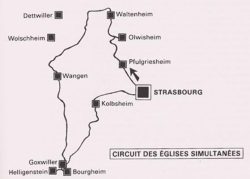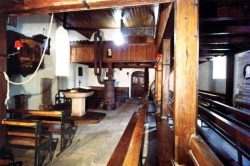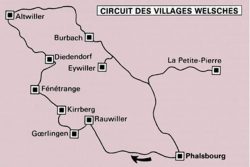The Lower Rhine
The simultaneum (simultaneous worship) persists in several places around Strasbourg
In Pflügersheim the simultaneum has existed in the church – built in the 11th and 12th centuries – since the Revocation. Until 1973 there were two altars, one Protestant and one Catholic, only one remains today.
In Olwisheim the small village church of the 11th and 12th centuries, dedicated to Saint Peter and Paul, became a simultanuem place after 1717.
In Waltenheim, Saint-Stephen church with its splendid Gothic choir has belonged to the simultaneum since 1686. It is the same in Dettwiller, Wolscheim and Wangen.
Goxwiller became Reformed in 1554. In the Romanesque church – redesigned several times – the choir was dedicated to Catholic worship after 1763. Above the Catholic altar is a very beautiful carved altarpiece, a 1561 Bible can be seen on the Protestant altar.
Hunawihr, a fortified church of the 12th century still is a simultaneum church.
Heiligenstein, Bourgheim and Kolbsheim each have a Protestant church used every year or several times a year by the Catholics.
West of the Hanau county, Welsches villages can be seen
The deserted villages were rebuilt and repopulated by Huguenot refugees welcomed by Count Adolphe de Nassau-Sarre-Wenden in 1550. They were called ‘Welsh’, a scornful sound derived from the German word meaning ‘Gaulish’.
The Ban-de-la-Roche and Pastor Oberlin
In southern Lower Rhine an important commemorative site of Alsatian Protestantism is situated and is linked to Pastor Jean-Frédéric Oberlin (1740-1826) in Ban-de-la Roche.
Considered as the father of the valley, Oberlin promoted the building of schools, especially that of the ‘Pont de la charité’ on the Bruche, as well as cultivating potatoes. He was a pioneer in agriculture as in pedagogy, and a forerunner in Social Christianity. He also introduced the textile industry along with Daniel Legrand from Basel and established the first social insurance system for workers.
Waldersbach houses the Oberlin museum in the former presbytery.
Sélestat was Martin Bucer’s hometown.
Other commemorative sites in the Lower Rhine
Hanau county along with Strasbourg were cornerstones of the Lutheran faith in Alsace. The Reformation appeared in 1545 and 1570 in the county ruled by Counts Hanau-Lichtenberg and Bitche-Deux-Ponts.
A Reformed walk links Wissenbourg and Soultz-sous-Forêts.
As early as 1523, the Reformation was established in the region that became French only in 1787. Until then it belonged to the duchy of Palatinat-Deux-Ponts, in 1588 the Duke Jean I adopted the Calvinist faith. In 1731, as a result of various successions, it was added to the Deux-Ponts Bischwiller duchy, reformed since 1545, and a place of refuge for people from Strasbourg forbidden to worship after 1577 and also for Huguenots expelled from Phalsbourg that belonged to Lorraine since 1617. Bischwiller had a Calvinist pastor as early as 1545.
The church in Bischwiller, built in 1300 by Frédéric de Lichtenberg, Bishop of Strasbourg, was fortified. It was dedicated to Our Lady and became Reformed in 1525, the parishioners being either Lutheran or Calvinist. In 1723, the parish was rich enough to afford an organ built by the famous Andreas Silbermann. Today it is classified as a Historical Monument. The church contains the vault of the Princes of Deux-Ponts.
Saint-Nicolas church in Hanhoffen was built in the late 12th century and became Reformed in 1525, but became Catholic again in 1686, and a simultaneum was established in 1859. Despite numerous changes, the interior of the church remains Romanesque.
The Lower Rhine
le bas-rhin
Bibliography
- Books
- DUBIEF Henri et POUJOL Jacques, La France protestante, Histoire et Lieux de mémoire, Max Chaleil éditeur, Montpellier, 1992, rééd. 2006, p. 450
- LAURENT René, Promenade à travers les temples de France, Les Presses du Languedoc, Millau, 1996, p. 520
- REYMOND Bernard, L’architecture religieuse des protestants, Labor et Fides, Genève, 1996
Associated notes
-
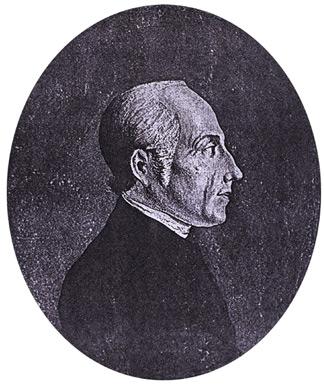
Jean-Frédéric Oberlin (1740-1826)
-
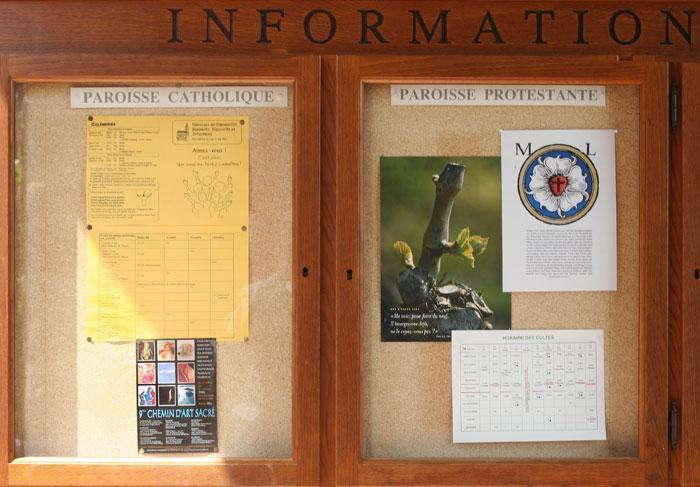
The simultaneum
The simultaneum was a result of Alsatian history. It is a religious building used simultaneously for both Catholic and Protestant worship. -
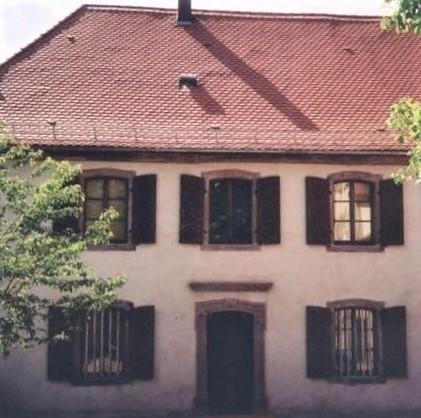
Jean-Frédéric Oberlin Museum
The subject of the Oberlin museum is Jean-Frédéric Oberlin (1740-1826), a pastor noted for his new approach to agriculture and teaching. He was also a forerunner of social Christianity. -
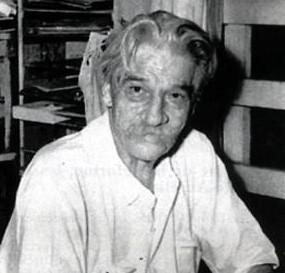
The Upper-Rhine

